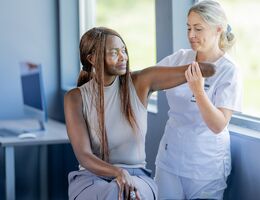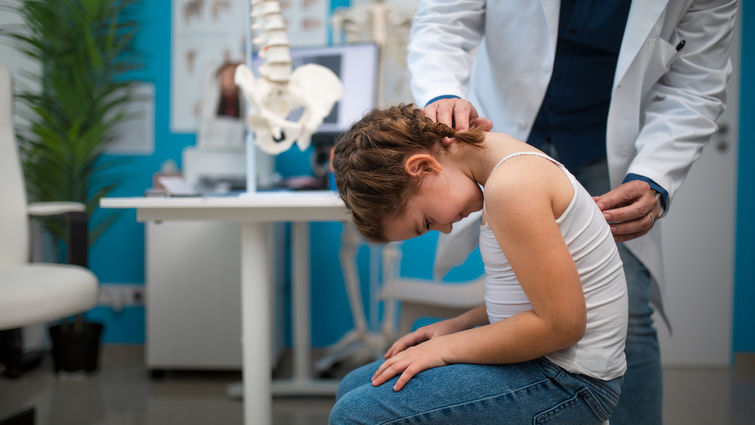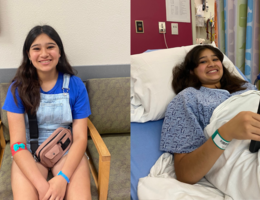

Scoliosis is a spine condition that can develop at any age but commonly presents itself before puberty in children between the ages of 10 – 15. When scoliosis is present in a child, it means that the typical alignment of the spine changes, resulting in a curve or a twist that can cause an imbalance of the body’s natural structure.
Depending on the severity of scoliosis, it can present as a mild curve that stabilizes over time, while in some cases, it can progress rapidly and require intervention.
Ronald Roiz, an orthopedic surgeon and scoliosis specialist at Loma Linda University Health, offers guidance on recognizing signs of scoliosis in children's spines and dispels common misconceptions about its causes.
Symptoms and signs of scoliosis
Although diagnosing scoliosis typically requires the Adams forward bend test, Roiz says there are visible signs that parents can watch for in their children.
-
Uneven shoulders: One shoulder may appear higher than the other.
-
Uneven waist: The waist may look uneven or off-balance.
-
One side of the pelvis is higher than the other: The pelvis may be misaligned, with one side higher.
-
Prominent ribcage on one side: When bending forward, one side of the ribcage may stick out more.
-
Head not centered over pelvis: The head may not line up directly over the pelvis.
-
Leaning to one side: A noticeable lean to one side when standing.
-
Forward left chest wall: Some girls may notice their breasts or ribs are more prominent on the left side due to the chest wall twisting.
Testing for scoliosis
The initial diagnostic for scoliosis is usually conducted with a noninvasive test known as the Adams forward bend test, where a child bends forward at the waist, and a doctor checks for any visible unevenness in the rib cage or back muscles.
Scoliosis can also be checked with a special tool called the scoliometer, which can measure the spine's tilt. If a spine tilts more than 7 degrees on the scoliometer, Roiz says it warrants an X-ray. While the Adams forward bend test and the scoliometer are practical and helpful screening tools to identify potential scoliosis, X-rays are standard for diagnosis and management.
Roiz also notes that families with a history of scoliosis should consider having their children regularly checked, as scoliosis has a genetic component and can be inherited.
How does scoliosis happen?
The most common form of scoliosis, adolescent idiopathic scoliosis, typically develops just before a child's adolescent growth spurts, around age 10 for girls and age 12 for boys. During this time, the spine changes shape, and some bones start growing excessively in the front than in the back, which makes the spine start to curve. There is no medical explanation for why some children develop the condition and others do not, meaning any child can develop scoliosis.
Although scoliosis can happen to anyone, it often shows up more in girls during their teenage years, with females being eight times more likely to develop scoliosis to the magnitude that requires treatment.
While some children develop a spinal curve that grows to the point where treatment is required, in most cases, the curve in a child’s spine is very small and does not require medical intervention.
Treatment options
If your child has a progressive scoliosis, it’s important to take the proper steps to stabilize the spine before it gets too big. When left untreated, severe spinal deformities can impair body image, cause discomfort, lead to breathing problems, or affect mobility. In extreme cases, the spine can continue to curve and collapse, creating a pronounced lean or hunchbacked appearance.
Treatment depends on the severity and progression of the curve and can include bracing, surgery, and possibly physical therapy.
Bracing: For mild to moderate cases, bracing is a standard approach. “Braces are external devices that use rigid plastic and foam to push on the spine through the ribs to push the spine back into better alignment,” Roiz says.
Ideally, a brace is worn for at least 18 hours a day and is typically recommended until a child's growth is complete, which can range from one to two years for most adolescents. While bracing can be uncomfortable, studies show it can be effective in controlling scoliosis without the need for surgery.
Surgery: While avoiding surgery is ideal, if scoliosis is not stabilized while a child is done growing, there is a possibility their spine will curve too much and will continue to collapse with age. In these cases, surgery may be required to stabilize the spine. This internal stabilization can prevent the spine from further collapse and maintain a safer alignment into adulthood.
Physical Therapy: While some specialized scoliosis exercises may be beneficial, the evidence remains inconclusive. Certain exercises might help manage discomfort, but they are not a substitute for bracing or surgery when the condition is severe.
Debunking popular myths about scoliosis
Parents often have a lot of anxiety about the causes of their child’s scoliosis, which can cause them to direct misguided blame on the child. Roiz wants to ensure that everyone knows that scoliosis is not a self-imposed problem.
The following are a few common myths regarding scoliosis.
Myth #1: Bad posture causes scoliosis
Parents are often concerned that their child’s posture is the cause of their scoliosis, but Roiz says that is false. “Just about every child has ‘bad posture,’ but only around 3% of children develop scoliosis,” he says. “We know posture is not a trigger of scoliosis since we are always moving, changing the alignment of our spine.”
Myth #2: Heavy backpacks cause scoliosis
Another common concern is children wearing heavy backpacks. However, Roiz confirms that scoliosis is not caused by carrying heavy loads and is not a factor in developing or worsening the condition.
Myth #3: Exercise and stretching can correct scoliosis
Physical activity is beneficial for back strength, but it cannot reverse scoliosis. While specific exercises may support spinal stability and manage symptoms, only medical treatments like bracing or surgery can alter the spine’s curvature.
If your child has scoliosis, Loma Linda University Children's Hospital can help. To learn more, click here or call 877-558-6248.


